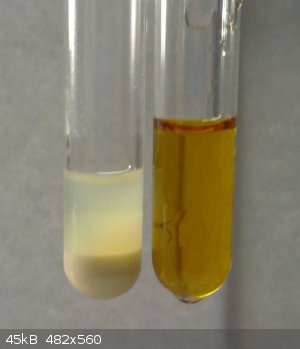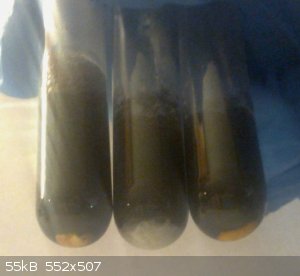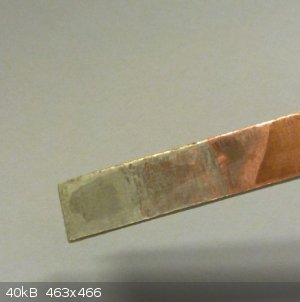experimental
Harmless

Posts: 21
Registered: 9-7-2017
Member Is Offline
Mood: curious
|
|
Issues with stannous sulfate
Does anyone have a reference for the solubility of stannous sulfate?
Wikipedia says it's 33 g/100mL but when I try to make it by reacting metallic tin with copper sulfate, the resulting solution settles at the bottom of
the beaker despite being just a few grams in 50 mL of water.
Also, if someone has experience working with it, is there an easy way to remove the white stains it leaves to the side of the beaker when heated? They
appear at the water line and seem to be insoluble in either hydrochloric or sulfuric acid.
|
|
|
unionised
International Hazard
    
Posts: 5126
Registered: 1-11-2003
Location: UK
Member Is Offline
Mood: No Mood
|
|
How are you sopping the air getting to the tin (II) and oxidising it to stannic oxide?
|
|
|
Σldritch
Hazard to Others
  
Posts: 309
Registered: 22-3-2016
Member Is Offline
Mood: No Mood
|
|
If you are using excess cupric sulfate it will oxidize the tin to stannic oxide.
(Which is soluble in conc. H2SO4 and "normal" NaOH)
|
|
|
experimental
Harmless

Posts: 21
Registered: 9-7-2017
Member Is Offline
Mood: curious
|
|
I didn't know that could be an issue. Acutally the residue left at the sides of the beaker could be stannic oxide, as it adheres to glass quite well.
I only tried cleaning it with dilute sulfuric acid, will try with NaOH and see if it soluble.
That is likely to solve the cleaning issue, but now I have a bigger issue, how to prevent oxygen in the air from getting at my product. Any
suggestions in this regard?
By the way, what I'm trying to do is to use tin sulfate for plating tin on copper. It shouldn't be too hard, I hope.
|
|
|
woelen
Super Administrator
        
Posts: 8014
Registered: 20-8-2005
Location: Netherlands
Member Is Offline
Mood: interested
|
|
Your main problem is hydrolysis. Sn(2+) ions can hardly exist in water at medium pH. They hydrolyze as follows:
Sn(2+) + H2O ---> [Sn(OH)](+) + H(+)
[Sn(OH)](+) + H2O <--> Sn(OH)2 + H(+)
The latter precipitates as a white solid. Clear solutions of tin(II) salts only are possible at very low pH.
|
|
|
Melgar
Anti-Spam Agent
    
Posts: 2004
Registered: 23-2-2010
Location: Connecticut
Member Is Offline
Mood: Estrified
|
|
Actually if you want a stannous sulfate solution, your best bet might be tin metal, sulfuric acid, and careful addition of H2O2. Too little and the
sulfate will be reduced to SO2 and tin sulfide. Too much, and you'll have an insoluble oxide. When I did it, I added a little bit every time I
noticed the smell of H2S (from acid hydrolysis of the sulfide).
However, stannous chloride is really easy to plate onto copper, so you probably don't need to go through the trouble. Just use a tin anode to deal
with the chlorine issue, and problem solved. That way your tin ion concentration stays relatively stable too.
[Edited on 8/24/17 by Melgar]
The first step in the process of learning something is admitting that you don't know it already.
I'm givin' the spam shields max power at full warp, but they just dinna have the power! We're gonna have to evacuate to new forum software!
|
|
|
experimental
Harmless

Posts: 21
Registered: 9-7-2017
Member Is Offline
Mood: curious
|
|
Thanks Melgar for the suggestion. I tried on a very small scale given that you mentioned the possible production of H2S.
I started with 1.2 grams of tin metal, 1 ml of water, 1 ml of concentrated sulfuric acid, gentle heating and adding dropwise H2O2 to a total of 1 ml.
I weighted the tin metal at the end of the reaction at 0.7 g, so around 0.5 grams of tin were consumed.
However I must have done something wrong, as the solution turned yellow, which is not the colour of stannous sulfate.
For reference I pictured the resulting yellow solution (right), and the previous attempt of reacting tin metal and copper sulfate (left).
Still no success, I'll just keep experimenting.

|
|
|
aga
Forum Drunkard
    
Posts: 7030
Registered: 25-3-2014
Member Is Offline
|
|
Bravo !
|
|
|
SWIM
National Hazard
   
Posts: 970
Registered: 3-9-2017
Member Is Offline
|
|
Could it be lead contamination in your tin causing that yellow?
Is it tech grade?
|
|
|
experimental
Harmless

Posts: 21
Registered: 9-7-2017
Member Is Offline
Mood: curious
|
|
I tried another experiment. Electrolysis of tin in 50 % sulfuric acid. Again, it didn't work as expected. I used tin for both electrodes, and tried
with 12 V, mainly for convenience. Bubbles were evolving from both electrodes, probably water electrolysis. Current was somewhere between 0.3 A and
0.6 A.
After a few hours one of the electrodes (can't remember which) turned black and some black soot-like substance was present in the beaker. I weighted
the electrodes, but no significant weight loss occurred, around 0.1 g, comparable to the resolution of my scale.
Tin may have reacted with the oxygen being produced by the water electrolysis to produce tin oxide.
But also lead dioxide is black. The tin I'm using was bought online, maybe it is a tin lead alloy.
|
|
|
UC235
National Hazard
   
Posts: 565
Registered: 28-12-2014
Member Is Offline
Mood: No Mood
|
|
Sn(II) is very sensitive to air oxidation, with SnO2 being a very energetically favorable place to stop. Much like in Co(II), I'm quite certain halide
counterions go a long way toward stabilizing it, hence the ubiquity of SnCl2.
Have a look at DOI: 10.1039/JR9600004000
SnSO4 is prepared by reaction of tin metal with copper sulfate in dilute sulfuric acid under nitrogen. The solution is boiled, concentrated under
vacuum and the crystals filtered, rinsed with alcohol, and ether, and dried.
They report that it is stable when dry in contact with air over a period of months. It is better stored under vacuum in the dark.
Solutions are obtainable and remain clear when containing >18.9g SnSO4 per 100ml water. Below this, there is hydrolysis to insoluble basic tin
sulfates.
|
|
|
AJKOER
Radically Dubious
    
Posts: 3026
Registered: 7-5-2011
Member Is Offline
Mood: No Mood
|
|
My view is that the interactive reactants here are water and oxygen acting in succession.
First, the hydrolysis reaction discussed by Woelen:
Sn[(H2O)6](2+) + H2O = Sn[(H2O)5(OH)]+ + H3O+
Reference: See, for example, for the case with iron at: http://www.geo.utexas.edu/courses/376m/coord_chem.htm
Now the above reaction could be moved to the right with another reaction consuming H+ like the below summary net electrochemical based reaction
involving oxygen and an aqueous stannous salt:
Sn(ll) aq + 2 H+ + 1/2 O2 → Sn(lV) + H2O (see, for the case of iron: http://corrosion-doctors.org/Experiments/rust-chemistry.htm )
The associated half cell reactions I would expect are:
Cathode: 1/2 O2 + 2 H+ + 2 e- ---> H2O
which is based on page 20-13 at http://www.public.asu.edu/~jpbirk/CHM-115_BLB/ClassNotes/chp... , and also my prior comments with respect to iron and copper on SM discussed at:
https://www.sciencemadness.org/whisper/viewthread.php?tid=73... ).
Anode: Sn(ll) ---> Sn(IV) + 2 e-
I would expect agitation of the solution, increasing the amount of dissolved oxygen, and the presence of a very small amount of NaCl, could expedite
the reaction.
[Edited on 12-9-2017 by AJKOER]
|
|
|
experimental
Harmless

Posts: 21
Registered: 9-7-2017
Member Is Offline
Mood: curious
|
|
I finally understood at least one of the reasons why my attempts were producing strange results. The tin I was using contains lead.
To discover it I tried the lead test proposed here https://www.sciencemadness.org/whisper/viewthread.php?tid=13... Since it was the first time I've done this test, I used a sample of leaded and
lead free solder wire for comparison.
On the left there's the leaded solder, on the center the lead free solder, and on the right the supposedly pure tin I was using for the experiment.
It's hard to see, but there's a yellow precipitate indicating the presence of lead.
I guess I'll have to get better tin to make stannous sulfate. Or maybe use the lead free solder?

|
|
|
experimental
Harmless

Posts: 21
Registered: 9-7-2017
Member Is Offline
Mood: curious
|
|
Finally I had success in tin plating. Since my last attempt there was one major breakthrough: NurdRage has posted a video on the subject.
Apparently my mistake was insisting on stannous sulfate while stannous chloride works as well but is much easier to prepare.
That, and using leaded solder without knowing it.

|
|
|